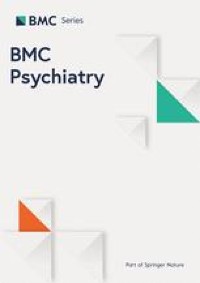Construction and verification of aggressive behavior risk prediction model in stable patients with schizophrenia – BMC Psychiatry
Construction and verification of aggressive behavior risk prediction ... BMC Psychiatry



Design
In this study, patients with schizophrenia who met the inclusion criteria were enrolled based on convenience sampling from two psychiatric specialty hospitals in Daqing City and Chifeng City between March 2021 and July 2023. Patients with schizophrenia from Daqing Municipal Third Hospital were placed in the training set, and patients with schizophrenia from Chifeng Municipal Anding Hospital were placed in the validation set. The training set was used for model development and internal validation, whereas the validation set was used for external validation of the model. Patients enrolled in this study were divided into aggressive and non-aggressive groups based on whether there was at least one obvious and recorded personal attack episode (including obvious wounding and self-injurious behavior) following diagnosis.
Participants
Diagnostic interviews in this study were conducted independently by two deputy chief physicians using the International Classification of Diseases-10 diagnosis criteria. Inclusion criteria:
- Patients who met the International Classification of Diseases-10 diagnosis criteria for schizophrenia
- Patients who are 18–65 years old
- Patients who achieved the stable period through oral antipsychotic drug treatment
- Patients with partial insight
- Patients possessing communication and comprehension abilities, and those who could complete the given assessment
- Patients who voluntarily participated in this study
Exclusion criteria: patients with a coexisting history of mental developmental delay, dementia, and other mental disorders or those who were accompanied by severe physical illnesses. Ethical approval was obtained from the Ethics Committee of Harbin Medical University, and it conformed to the ethical guidelines of the Helsinki Declaration. All enrolled patients signed informed consent.
Information was gathered through direct encounters. Before conducting the survey, investigators received identical training-covering topics, including survey objectives, communication languages, potential obstacles during data collection along with remedies for such problems, and on-the-spot verification procedures for questionnaire legitimacy. Before filling out the questionnaires, comprehensive guidance on completion protocols was provided to ensure informed participation from the study sample. Following the on-site validations, questionnaires were considered complete and were logically organized after the survey.
Measures
General information questionnaire
The general information questionnaire designed by the research team includes gender, education level, marital status, number of recurrence, age of onset, age, duration of disease.
Positive and Negative Symptom Scale (PANSS)
The questionnaire consisted of 33 items and had a seven-level scoring system. Assessment indicators included the total score ranging from 30 to 210, positive and negative symptom scale scores ranging from 7 to 49, general psychopathology scale score ranging from 16 to 112. Higher scores on PANSS total score and various subscales indicate more severe clinical symptoms.
The Childhood Trauma Questionnaire-Short Form(CTQ-SF)
Comprising 28 items, this scale assessed five types of neglect or abuse (including emotional neglect, physical neglect, emotional abuse, physical abuse, and sexual abuse). Each item was rated on a five-point scale, with each subscale score ranging from 5 to 25, and the total score ranging from 25 to 125.
Connor- Davidson resilience scale(CD-RISC)
In 2003, Conner and Davidson developed a scale consisting of 25 items. Each item was rated on a Likert five-level scale, with the total score ranging from 0 to 100. Higher scores indicated better psychological resilience.
Self-esteem scale(SES)
In 1965, Rosenberg developed a scale designed to assess overall feelings of self-worth and self-acceptance in adolescent individuals. The scale consisted of 10 items, with higher scores indicating higher levels of self-esteem.
Statistical analysis
Data analyses were conducted using the Statistical Package for the Social Sciences 25.0 and R 4.3.1 (packages such as glm, predict, rms, and DynNom were used). Binary logistic regression was performed for variable selection and model construction. The optimal threshold for the prediction model was calculated based on the Youden index, and Nomogram was plotted. Bootstrap resampling was performed 1,000 times for internal validation, and the validation set data were used for external validation. The discriminative ability of the model was evaluated using the C-statistic (C > 0.7 indicating good discriminative ability), and model calibration was assessed through the calibration curves and Brier scores (scores < 0.25 were preferred). The significance level was set at α = 0.05.
SDGs, Targets, and Indicators in the Article
SDGs Addressed or Connected to the Issues Highlighted in the Article:
- SDG 3: Good Health and Well-being
- SDG 4: Quality Education
- SDG 5: Gender Equality
- SDG 10: Reduced Inequalities
- SDG 16: Peace, Justice, and Strong Institutions
Specific Targets Under Those SDGs Based on the Article’s Content:
- SDG 3.4: By 2030, reduce by one-third premature mortality from non-communicable diseases through prevention and treatment and promote mental health and well-being.
- SDG 4.3: By 2030, ensure equal access for all women and men to affordable and quality technical, vocational, and tertiary education, including university.
- SDG 5.5: Ensure women’s full and effective participation and equal opportunities for leadership at all levels of decision-making in political, economic, and public life.
- SDG 10.2: By 2030, empower and promote the social, economic, and political inclusion of all, irrespective of age, sex, disability, race, ethnicity, origin, religion or economic or other status.
- SDG 16.3: Promote the rule of law at the national and international levels and ensure equal access to justice for all.
Indicators Mentioned or Implied in the Article:
- PANSS (Positive and Negative Symptom Scale) scores: Indicators of the severity of clinical symptoms in patients with schizophrenia.
- CTQ-SF (Childhood Trauma Questionnaire-Short Form) scores: Indicators of neglect or abuse experienced by patients with schizophrenia.
- CD-RISC (Connor-Davidson Resilience Scale) scores: Indicators of psychological resilience in patients with schizophrenia.
- SES (Self-esteem Scale) scores: Indicators of self-worth and self-acceptance in patients with severe mental disorders.
Table: SDGs, Targets, and Indicators
| SDGs | Targets | Indicators |
|---|---|---|
| SDG 3: Good Health and Well-being | SDG 3.4: By 2030, reduce by one-third premature mortality from non-communicable diseases through prevention and treatment and promote mental health and well-being. | PANSS (Positive and Negative Symptom Scale) scores |
| SDG 4: Quality Education | SDG 4.3: By 2030, ensure equal access for all women and men to affordable and quality technical, vocational, and tertiary education, including university. | N/A |
| SDG 5: Gender Equality | SDG 5.5: Ensure women’s full and effective participation and equal opportunities for leadership at all levels of decision-making in political, economic, and public life. | N/A |
| SDG 10: Reduced Inequalities | SDG 10.2: By 2030, empower and promote the social, economic, and political inclusion of all, irrespective of age, sex, disability, race, ethnicity, origin, religion or economic or other status. | CTQ-SF (Childhood Trauma Questionnaire-Short Form) scores |
| SDG 16: Peace, Justice, and Strong Institutions | SDG 16.3: Promote the rule of law at the national and international levels and ensure equal access to justice for all. | CD-RISC (Connor-Davidson Resilience Scale) scores SES (Self-esteem Scale) scores |
Behold! This splendid article springs forth from the wellspring of knowledge, shaped by a wondrous proprietary AI technology that delved into a vast ocean of data, illuminating the path towards the Sustainable Development Goals. Remember that all rights are reserved by SDG Investors LLC, empowering us to champion progress together.
Source: bmcpsychiatry.biomedcentral.com

Join us, as fellow seekers of change, on a transformative journey at https://sdgtalks.ai/welcome, where you can become a member and actively contribute to shaping a brighter future.







